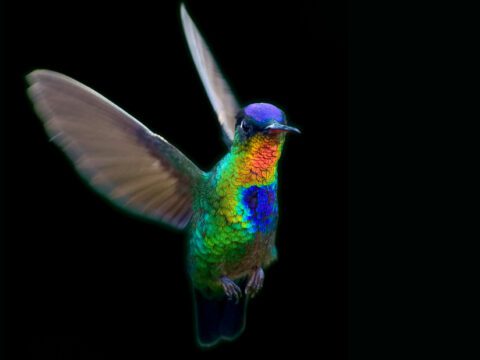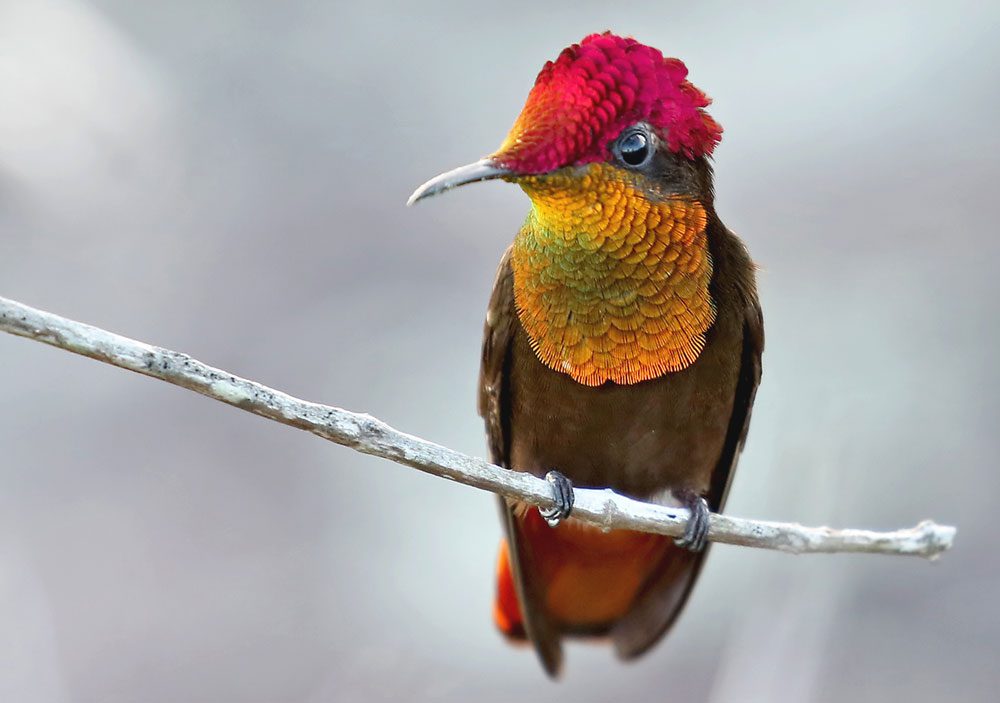What Is the Essence of Iridescence? Ask a Hummingbird
By Marc Devokaitis
June 28, 2023Microscopic secrets hidden away in hummingbird feathers manipulate light to give these tiny birds—the most colorful birds on Earth—the power to dazzle on command.
From the Summer 2023 issue of Living Bird magazine. Subscribe now.
A few years ago, Arizona photographer Steven Kessel was out capturing images of a male Anna’s Hummingbird basking in sunlight when he captured an amazing transformation.
At first, the hummingbird appeared to be a green-and-white bird with a black crown and throat (or gorget). Then the bird turned its head ever so slightly, raising a few of its crown feathers—and the crown color transformed into a muted magenta, with subtle sparkles of red and orange in the gorget. As the bird raised more feathers in its crown and throat, a crescent of magenta appeared around the edges of one side of its face, with shiny orange, yellow, and green filling out the other side. Finally, the bird turned to look at Kessel almost head-on, and its colorful facial feathers went ablaze with saturated hot pink.
“The pictures don’t really do justice to what I observed,” wrote Kessel on his blog. “With each change of position his head and neck showed different amounts of iridescence. It was an incredible display.”

The glowing, intensifying, changing colors of hummingbirds are one brilliant example of their off-the-charts biology. These smallest of warm-blooded animals also have the fastest wingbeats and heartbeat of any bird, and they are the only birds that can fly backward and straight up and down. If there were a bird version of competitive eating, they’d surely nab a prize for being able to consume half their body weight in food every day. And they have the amazing ability to lower their body temperature on a nightly basis to save energy: The Black Metaltail in the Peruvian Andes holds the record for lowest body temperature (38°F) ever recorded in a bird.
But it’s the mind-bending diversity of the hummingbird color palette that really sets the Trochilidae family apart from the rest of the bird world. Among the 360 or so hummingbird species, there is example after example of colors that seem to be plucked out of a prism: the iridescent rainbow of the Fiery-throated Hummingbird, the shimmering purple and green of the Sparkling Violetear, the searing magenta of Anna’s Hummingbird, and the now-you-see-it-now-you-don’t, night-sky violet of the Velvet-purple Coronet.
As it turns out, hummingbirds are not just a colorful group of birds, they are the most colorful family of birds on Earth. They produce and manipulate an otherworldly spectrum in ways that are unique within the biological world. And that’s captured the imagination of ornithologists across the Western Hemisphere (the only place where hummingbirds live), as a new wave of research is seeking to clarify how hummingbird colors are produced and how they function.
Their colorful discoveries are, in a word, dazzling.
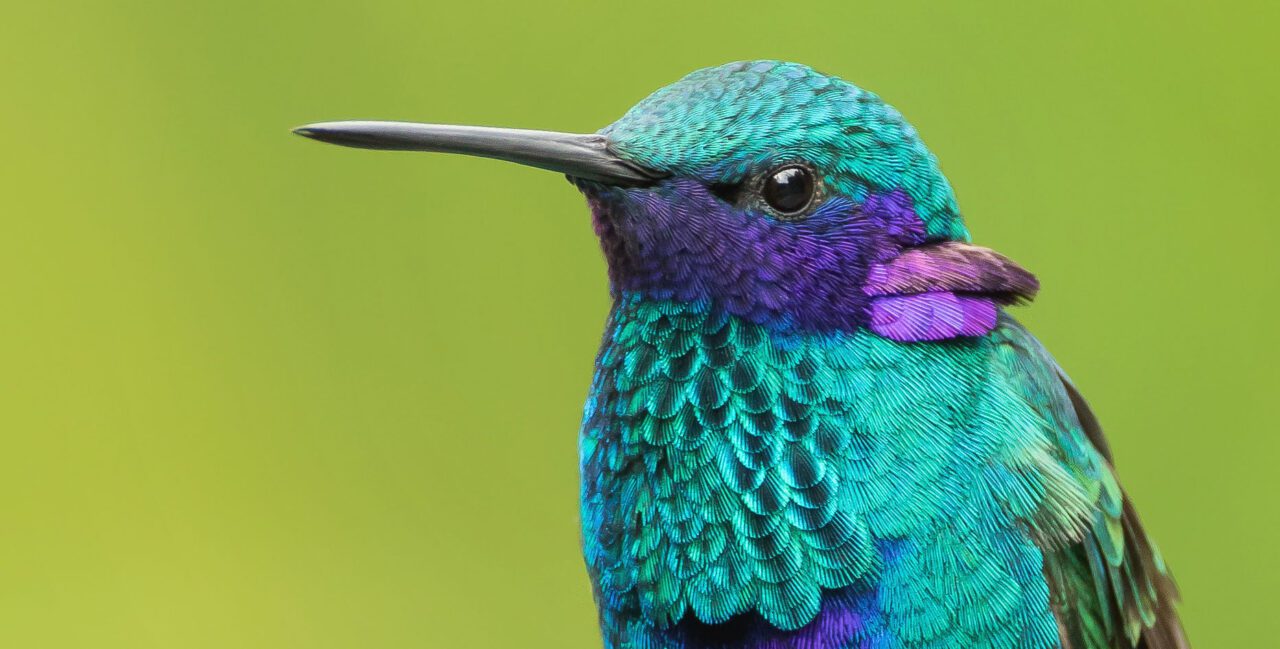
Fancy Males Must Vie to Be Noticed
According to ornithologist Kevin McGowan, the evolutionary conditions for a lot of hummingbirds are right for the kind of competition that produces a profusion of “fancy males.”
McGowan, who is a senior course developer for the Cornell Lab of Ornithology’s Bird Academy and recently authored a new course about hummingbirds, is referring to the theory of sexual selection, which dates back to Darwin. The theory posits that the eye-catching plumage of many male birds is a result of millions of years of brighter individuals competing more successfully for mates; evolution then favored traits for brightness that were passed down and amplified over time.
“There are places [in South America] where you could see 15 or 20 species visiting a single hummingbird feeder, with dozens of individuals of a single species,” says McGowan. “So in those circumstances, it becomes a question of, how can I make a splash? How can I get noticed?”
Last year a team of researchers from Yale University showed that hummingbirds really are the champions of the bird world when it comes to attention-grabbing colors. According to the team’s findings, published in the journal Communications Biology in 2022, the diversity of colors found in hummingbirds they examined exceeds that of all other bird species combined. And not just by a little—when hummingbirds were added to an existing inventory of the so-called bird color gamut (the full range of colors that birds can produce and detect), they increased that range by around 56%.
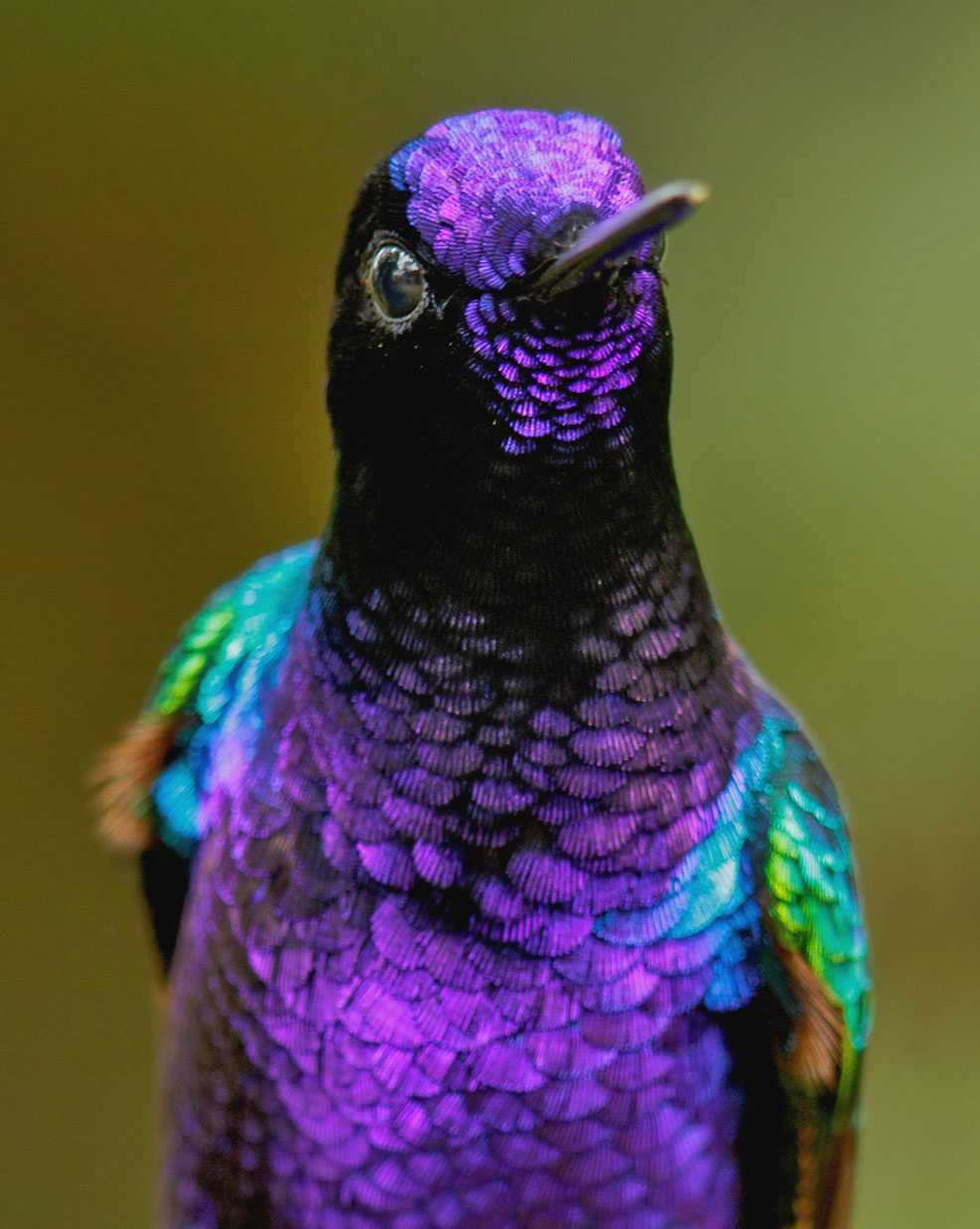
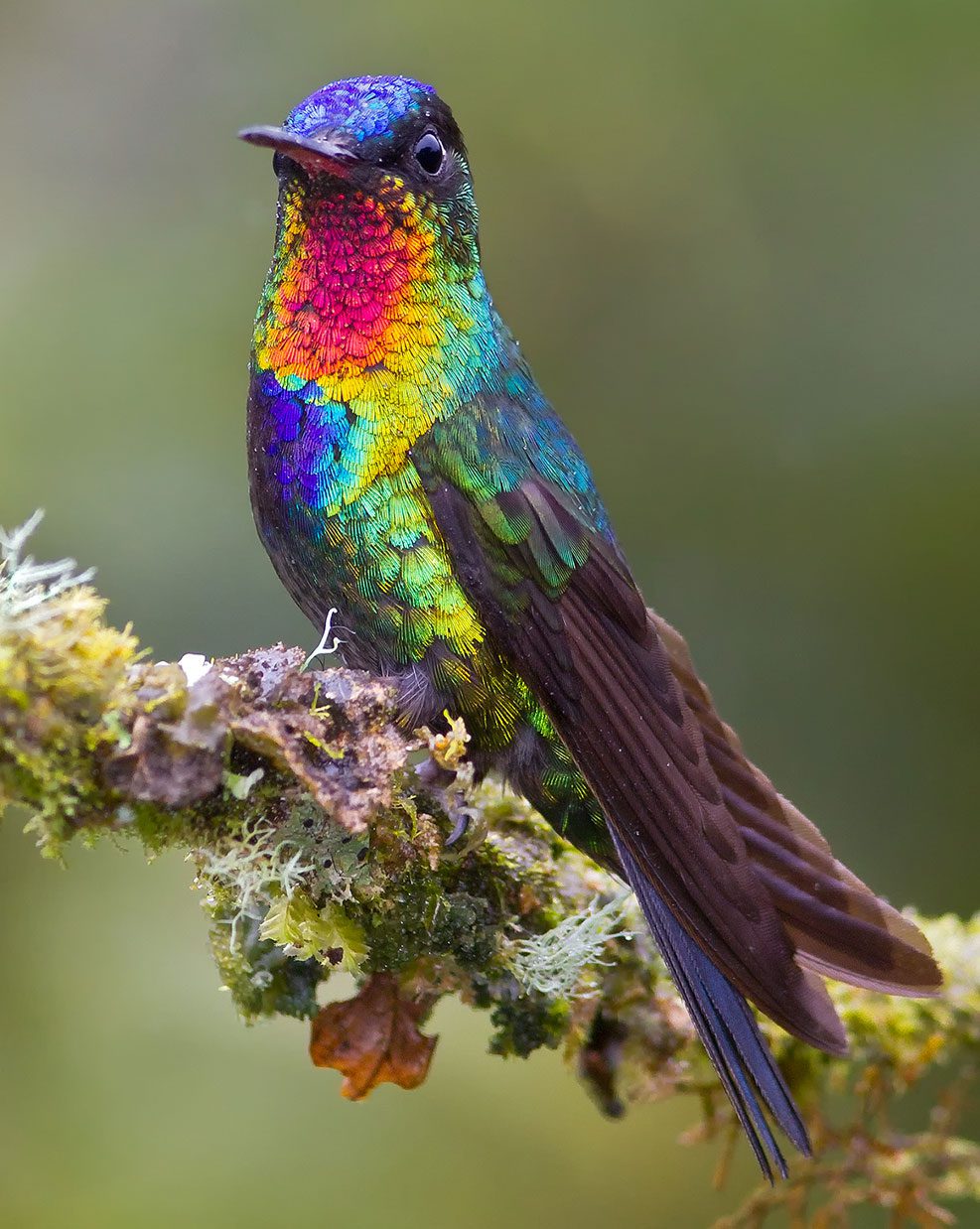
“We knew that hummingbirds were colorful, but we never imagined that they would rival all the rest of the birds combined,” says Richard Prum, a biology professor at Yale and senior author on the research, who has been studying bird coloration for more than three decades.
The study revealed that many hummingbirds produce colors that are rare in the rest of the avian world—and the natural world as a whole. The hummingbird spectrum includes saturated blues, blue-greens, and deep violets, as well as a host of ultraviolet and ultraviolet-blended colors that look one way to humans, but different to hummingbirds, such as UV-plus-green. The team measured not only the different hues (what scientists refer to as “chroma”), but also the saturation of those hues.
“One aspect of [hummingbird color] diversity comes from their ability to make high-chroma, pure-spectrum hues that are near the edges … of the avian color space,” says Prum, referring to the range of colors that birds should be able to see.
Prum agrees with McGowan that intense selection pressure is probably the reason that male hummingbirds have achieved such a wide range of hues.
“When we look at color diversity of crowns and throats in particular [the two parts of the hummingbird body that are used most frequently in displays], we find a much broader range of colors than on the bellies or tails or wings,” Prum says. “The only way to get more color in those areas is if there is selection pressure to do more interesting and cool things with them. That could be in terms of interaction, sexual display, or ecological competition.”
In other words, hummingbird males have become so colorful because they need to stay ahead of the curve in terms of attracting mates, or warding off rivals to mates or food sources.
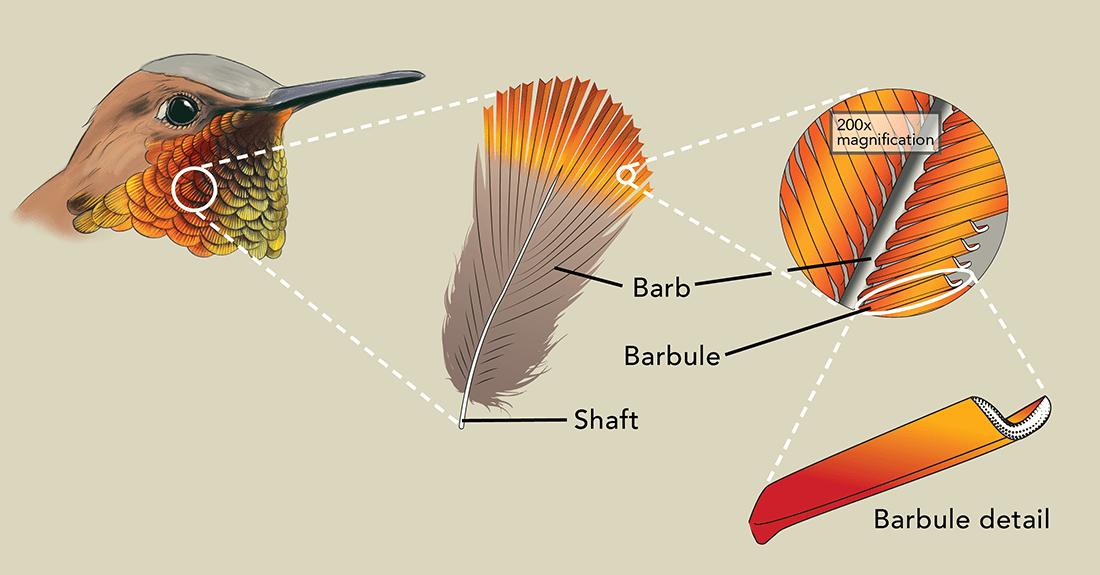
Hummingbird feathers—a Rufous Hummingbird pictured here—are made of keratin and consist of a main shaft with barbs. Each barb has filaments called barbules attached to it. Hummingbird feather barbules have evolved to act as a reflective surface that appears to change color depending on the angle of view. The flattened barbules overlap like Venetian blinds to create a surface perfect for reflecting brilliant colors. Swipe, tap, or click to see next images. Graphic by Jillian Ditner.
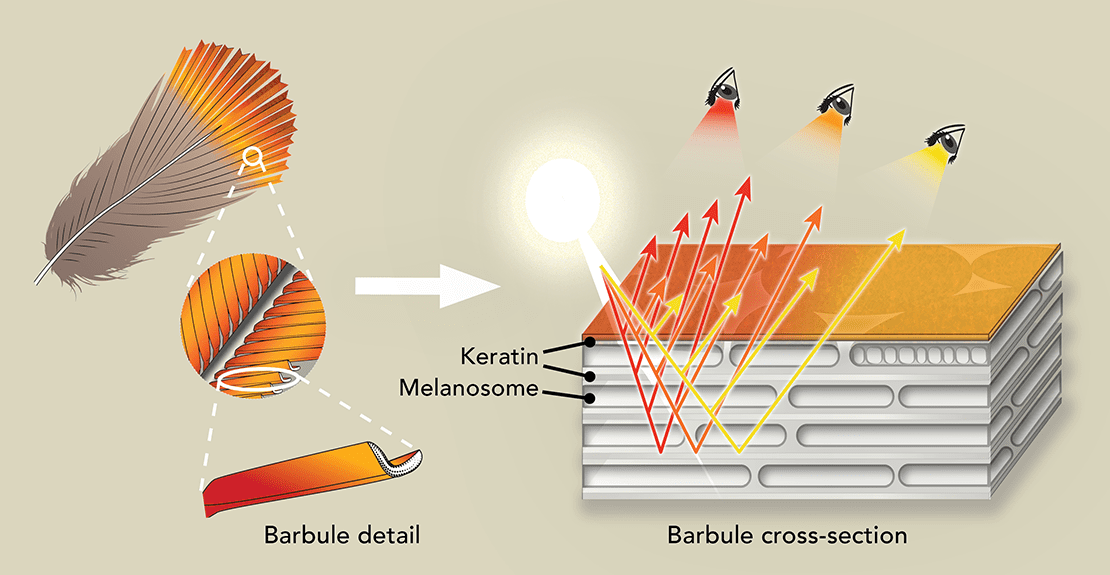
The cross-section of a hummingbird barbule reveals layers of hollow, air-filled structures called melanosomes. As light hits the top layer of the barbule, it refracts through a thin layer of transparent keratin and hits the top layer of melanosomes. Some light gets reflected, and some light passes through to the next layer of melanosomes—and so on, and so on, through as many as 15 layers. The color produced depends on the angle of view. Graphic by Jillian Ditner.
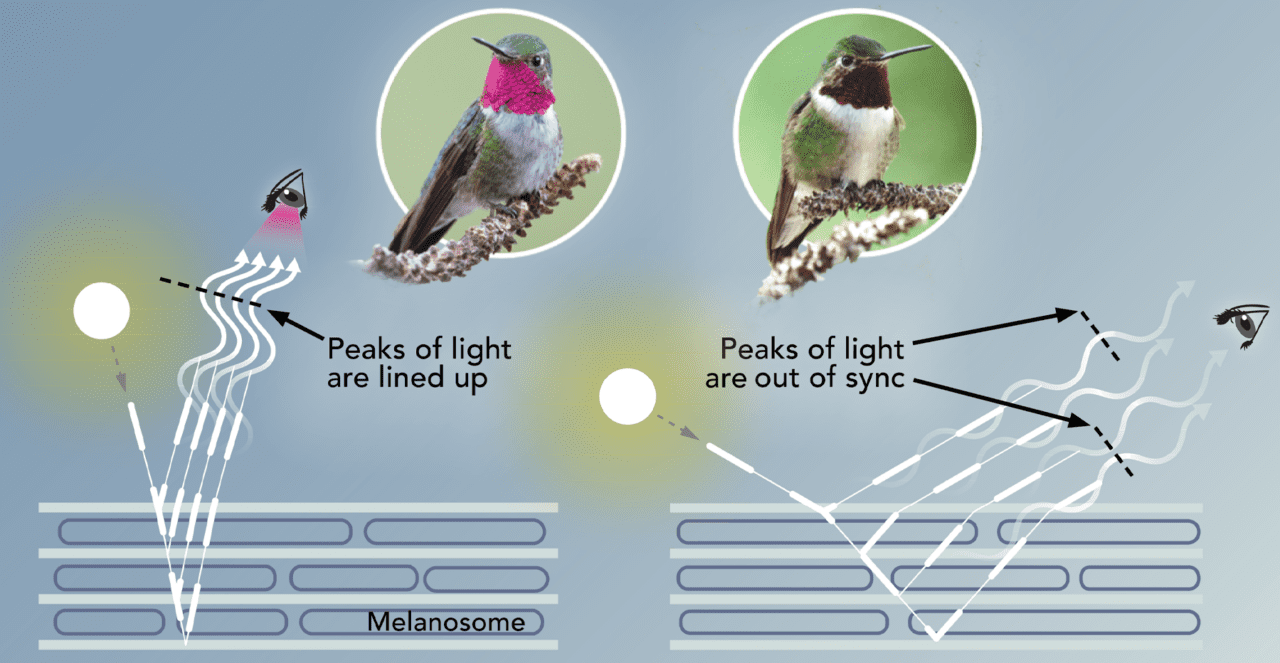
Many hummingbirds have gorgets and crowns that flash brilliantly at a certain viewing angle. The flash happens when reflecting light waves with similar wavelengths line up peak-to-peak and valley-to-valley—an amplifying effect known as constructive interference. When a gorget or crown appears dark, the light waves are out of sync and cancel each other out (destructive interference). Graphic by A.M. Dokter and Jillian Ditner; Broad-tailed Hummingbird photos from Macaulay Library by Ryan Sanderson (left) and Isoo O’Brien (right).
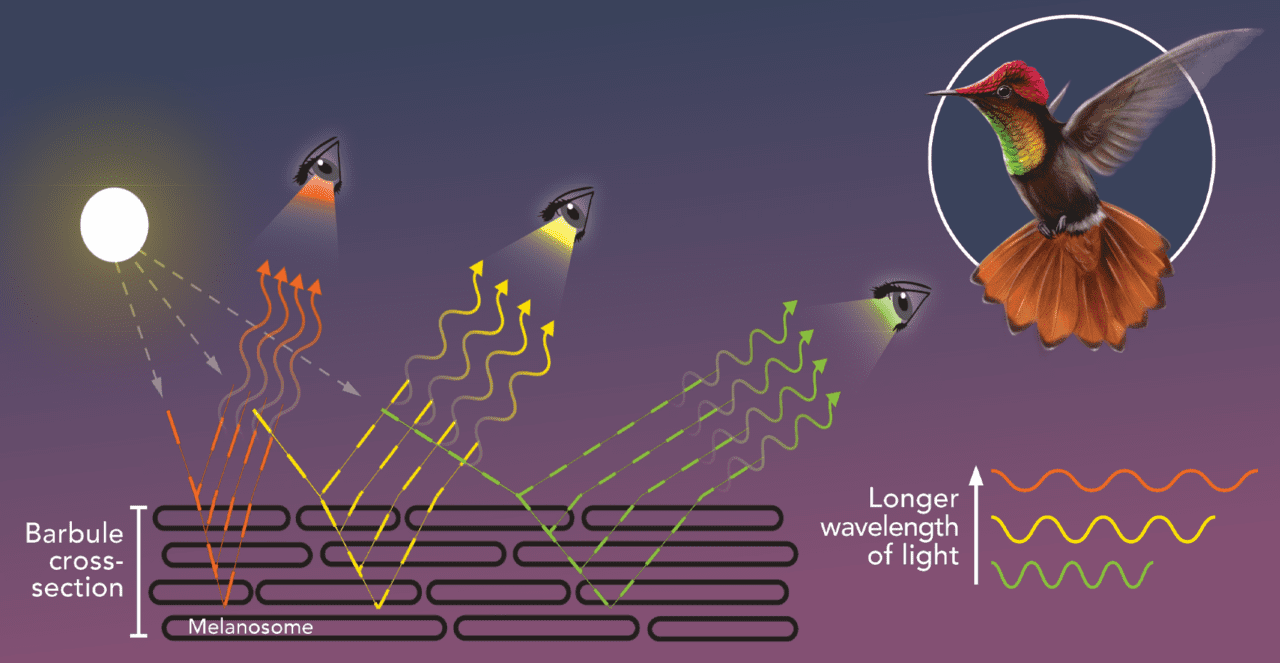
The composition and spacing of the melanosome layers determine the colors seen at various angles. Two main factors influence the color produced: view angle and melanosome thickness. In a hummingbird feather barbule, incoming light from the sun reflects off melanosome layers. These reflections can add up and amplify each other to create glittering flashes of color, or appear to change colors, depending on the viewing angle. Pictured are a Crimson Topaz (left) and a Turquoise-crowned Hummingbird. Graphic by Jillian Ditner.
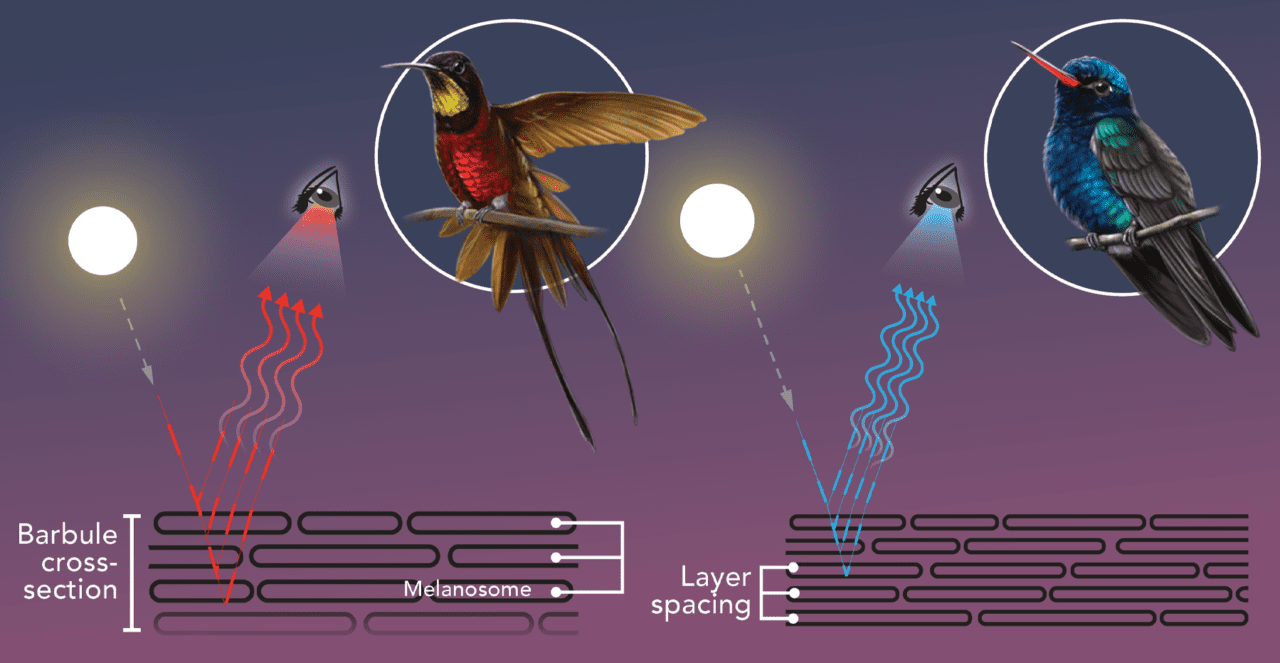
Colors produced by longer wavelengths of light—such as the red, orange, and yellow of this Ruby-topaz Hummingbird—are produced when the underlying barbule structure contains thicker melanosome layers. In contrast, cooler colors—like cyan, blue, and purple—have shorter wavelengths and are produced by thinner, more densely stacked melanosome layers. Graphic by Jillian Ditner.
Like Oil and Water—On a Very Tiny Scale
In another hot area of emerging research about hummingbirds, scientists are zooming in to nanoscopic scales to study just how hummers produce such supercharged colors.
According to Lorna Gibson, a retired materials-science professor from MIT who taught a course called “How Birds Work,” hummingbird feathers create their magical effects by capturing, bending, and reflecting beams of sunlight using almost inconceivably tiny structures built into their feathers.
Sunlight reaches the Earth as white light comprising a range of different light waves containing all of the visible colors of the spectrum for humans, and some invisible ones. When we see a colorful bird like a bright red Northern Cardinal, we are seeing waves of light reflected back to us via pigment molecules inside their feathers. Pigments absorb some wavelengths of light and reflect others. So the Northern Cardinal’s red pigments absorb all visible light wavelengths except red, which is reflected to our eye and becomes the color we see.
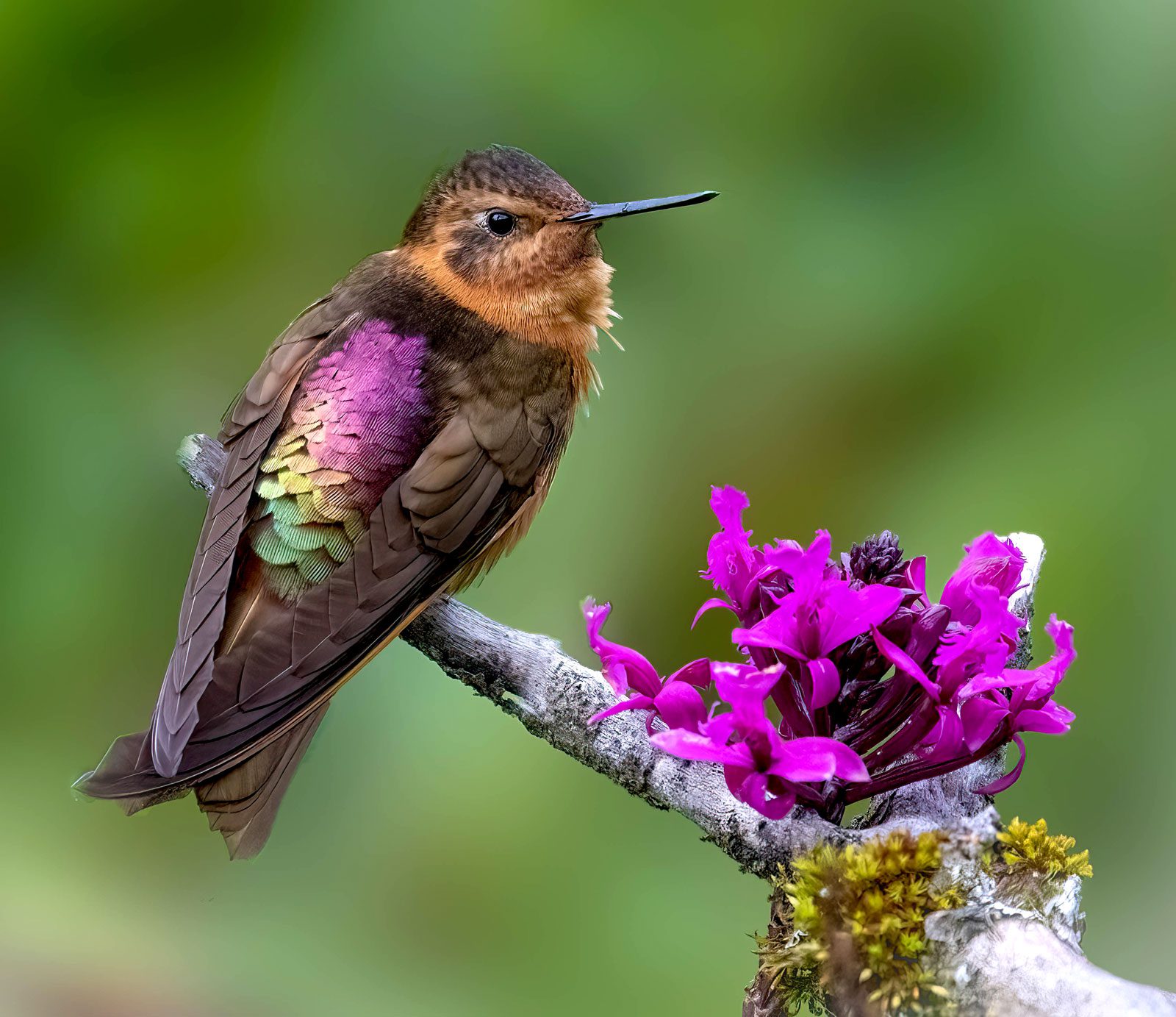
Gibson says that birds can make myriad color combinations with pigments in their feathers, including a full range of bright reds, yellows, and browns, as well as blacks and grays. Some groups of birds, like parrots and turacos, even have green pigments. But there are limits to how far feather pigments can go. No birds have pigments that produce the color blue, and pigments alone can’t produce a metallic shine or iridescence. The special-effects colors of hummingbirds are produced through the interaction of light waves with nanoscopic structures inside their feathers. According to Gibson, an oil slick is a great place to begin to understand the concept of iridescence and structural color in general.
“Oil and water doesn’t seem much like feathers, but it actually is,” says Gibson. Oil and water don’t mix, so when you see oil in a puddle of water, you are actually seeing a thin layer of oil on top of a layer of water.
“When the light hits the oil layer, some of it reflects off of the top of the oil, but some passes through,” says Gibson. “The light that travels through the oil is refracted,” or bent. Gibson points out that the bent light that passes through the oil layer then hits the surface of the water where it also reflects. “Now you have multiple waves that are reflecting back, but they’re all higgledy-piggledy.”
Juan Parra, an assistant professor of biology at the University of Antioquia in Colombia who has authored around a dozen papers on hummingbird color evolution and production, says that something similar, but far more complex, is happening with hummingbirds.
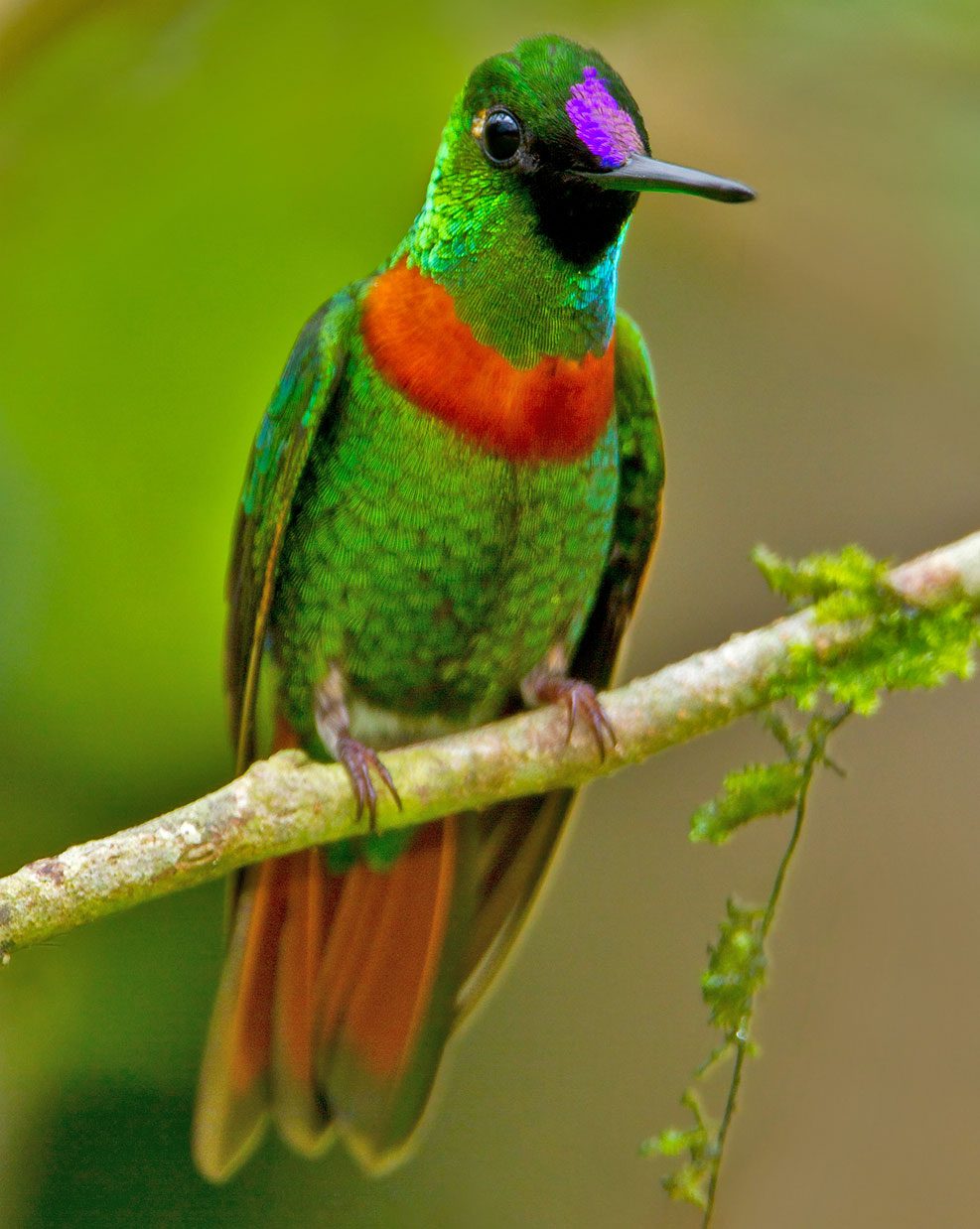
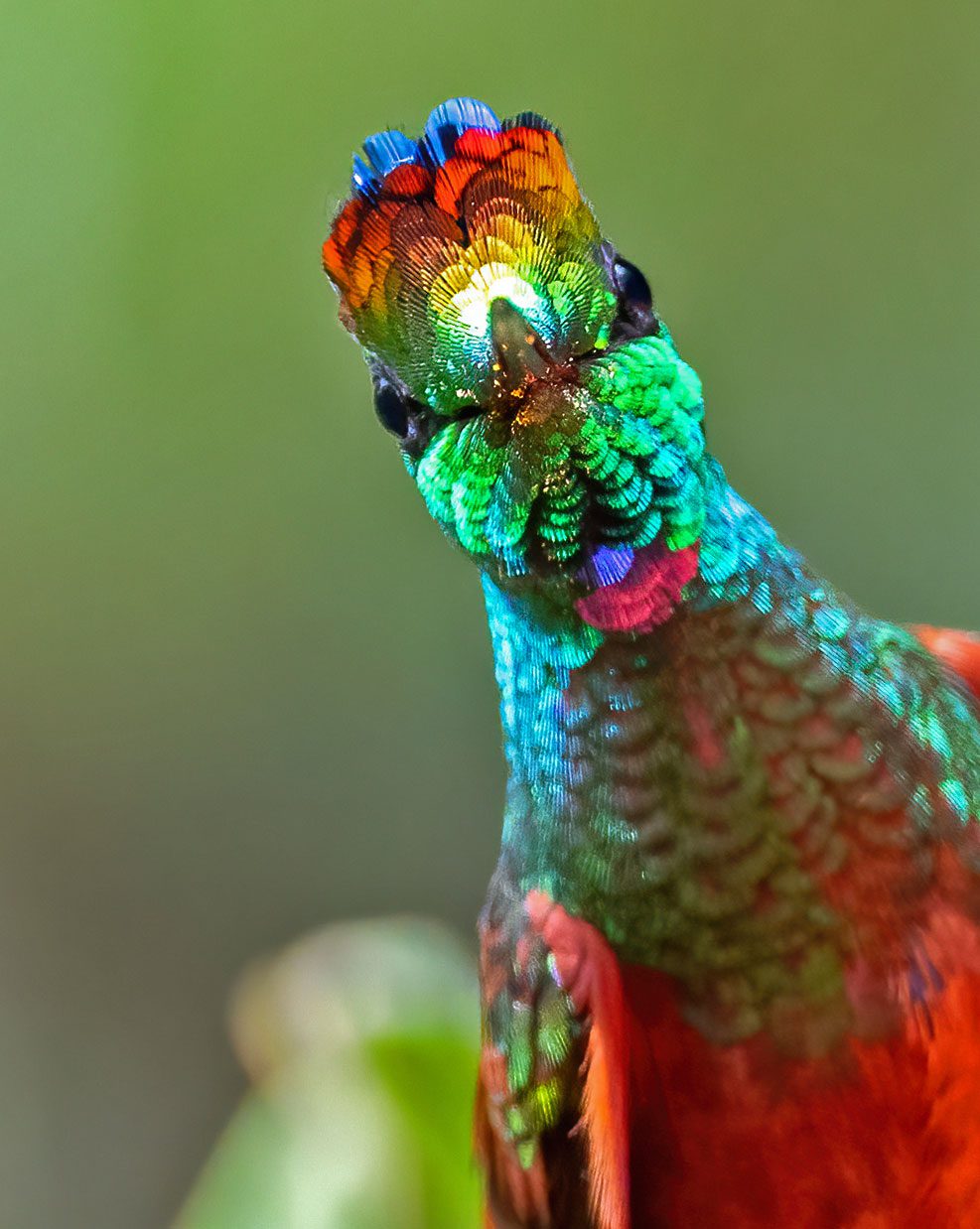
Parra says that hummingbirds have barbules—tiny structures at the outermost parts of their feathers—that are perfect for creating shiny, reflective iridescence.
“To get the effect, hummingbirds use thin flat surfaces to reflect the light,” says Parra. Most birds have round barbules, Parra explained, but hummingbird barbules are flattened, and contain layer after layer of flattened, air-filled discs called melanosomes, stacked on top of each other like pancakes. There can be as many as 15 of these melanosome layers per barbule, and this is where the magic happens. As light hits the top edge of the barbule, it refracts through a thin layer of transparent keratin and hits the top layer of melanosomes. Some light gets reflected, and some passes through, refracting (or bending) as it goes. The same thing happens as the passed-through light reaches the next layer, and the next, and the next: some light is reflected back, while some of it passes through. Parra says that when waves from these multifaceted reflections line up, it creates the brilliant colors we see.
“When the peaks and valleys of the waves are aligned,” says Parra, “the color gets amplified and we end up seeing not a normal red but a brilliant red.”
The precise color we (and hummingbirds) see depends on the finer points of the arrangement of the melanosomes. More densely packed, thinner layers generally result in colors on the blue and violet end of the spectrum. Thicker layers tend to create reds and oranges. Because there can be a dozen or more of these melanosome layers, the interplay between the sunlight and the nanostructures inside hummingbird feathers is extremely complex.
“For example, a blue color would usually have a single peak in the blue part of the color spectrum,” Parra says, referencing how ornithologists measure bird coloration using a tool called a spectrophotometer. But, he says, many colors produced by hummingbirds are based on a combination of peaks, such as a blue color with two peaks— one in the blue and another in the UV spectrum.
“How to develop two reflectance peaks based on the same structure is something we still do not understand fully,” Parra says. “That amazes me.”
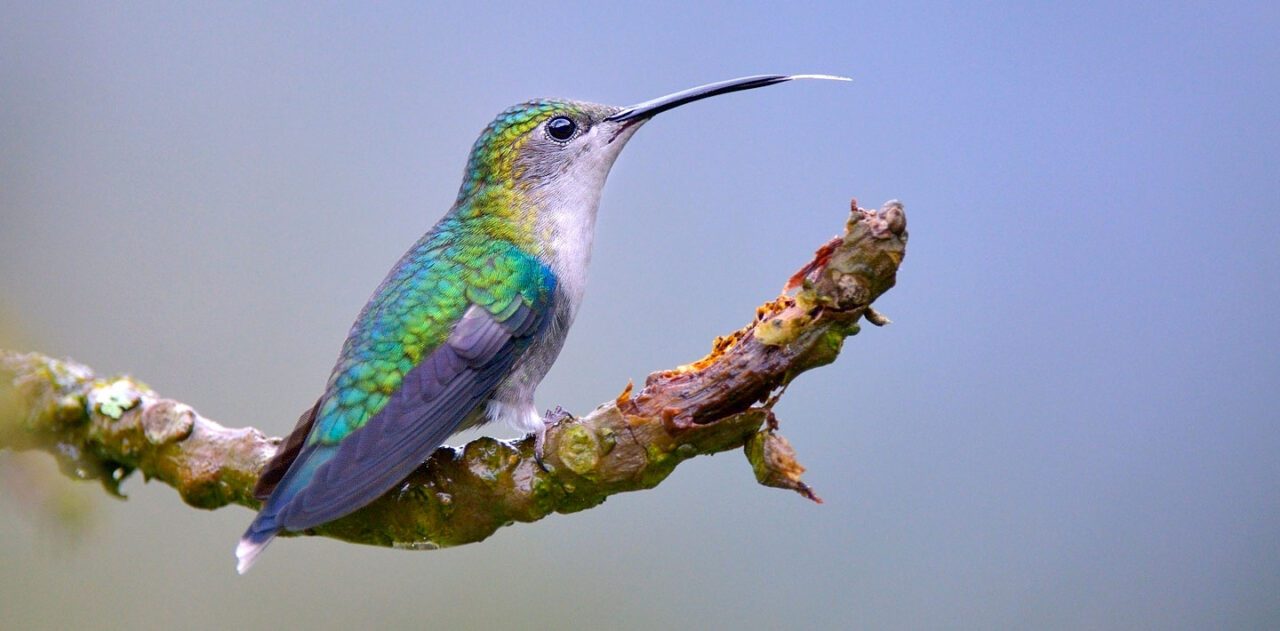
A Dazzling, Acrobatic Light Show
The next generation of scientists is breaking new ground, studying what hummingbirds are doing with all the bright colors they put out into the world.
Over the past seven years, Princeton University ecologist Mary Caswell Stoddard has been studying how Broad-tailed Hummingbirds use and perceive color at the Rocky Mountain Biological Laboratory in the heart of the Colorado Rockies. Stoddard and her team found that Broad-tailed Hummingbirds put on a dazzling, acrobatic light show during breeding season.
A male Broad-tailed Hummingbird doesn’t leave anything in the tank when he shows off for a female. First, he propels himself high into the air—as much as 100 feet up—where he pauses to hover and survey the scene. The stage set, he launches earthward, accelerating faster than the pull of gravity to reach speeds of up to 50 mph. Just before the bird reaches top speed, he makes a loud, machine-like buzz with his tail feathers, and angles himself toward the female to create a scintillating flash with his purple-red gorget.
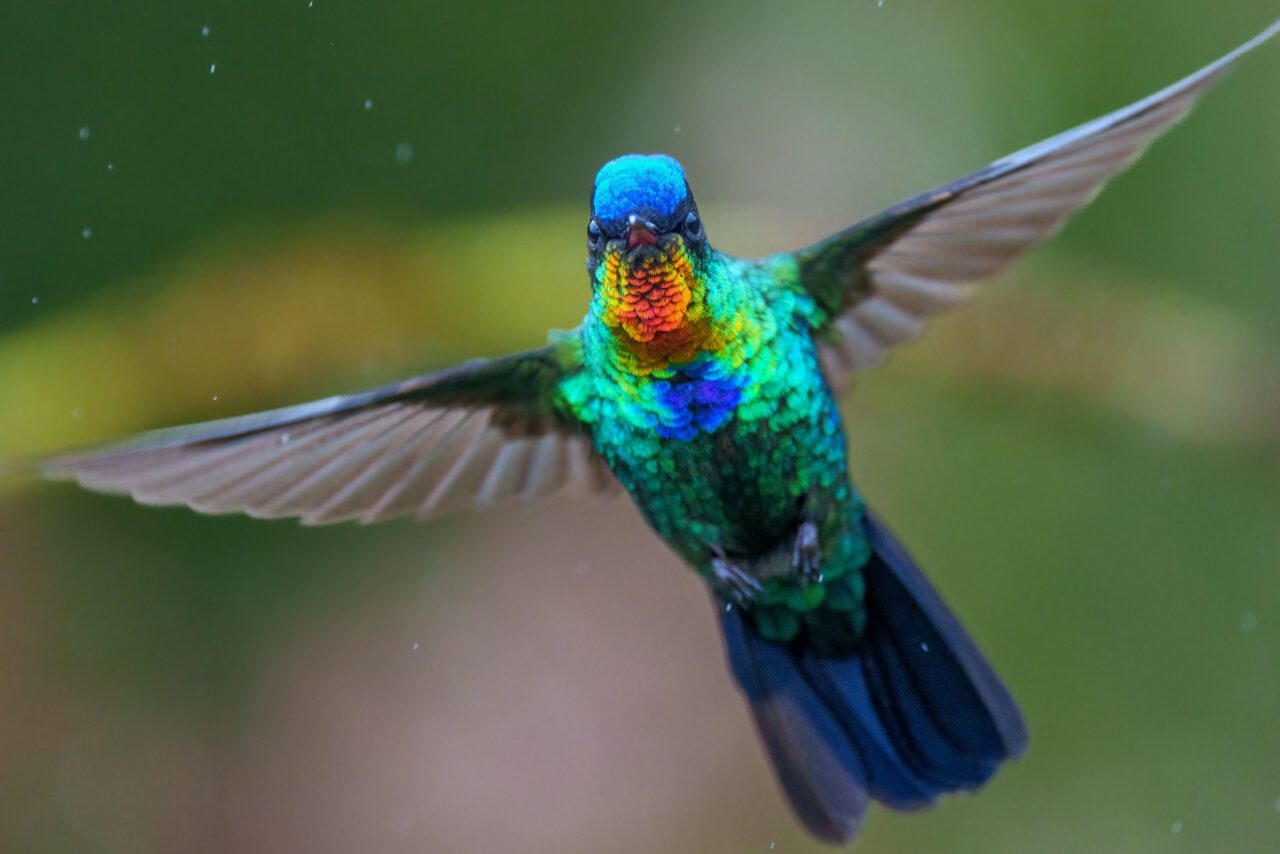
That flash of color is no accident. Stoddard and her team used HD video recordings of these ritualized behaviors to find that the males are angling their reflective crown and gorget toward the female in a highly coordinated display.
“The males are delivering this sensory explosion to females at the base of the dive. He’s buzzing his tail. He’s reaching his top speed and he’s flashing … what appears to be red to kind of dark green to dark greenish-black,” says Stoddard. “It’s all evolved to have maximum intensity at this one critical moment of the dive.”
Stoddard says she knows how these dramatic displays look to her and other human onlookers, but there is still a lack of information about how these colors (and sounds, for that matter) are actually perceived by the birds themselves.
“Doing behavioral experiments on bird vision in the field is very challenging,” she says, pointing to the fact that most experiments that aim to test bird vision have been done in a laboratory setting.
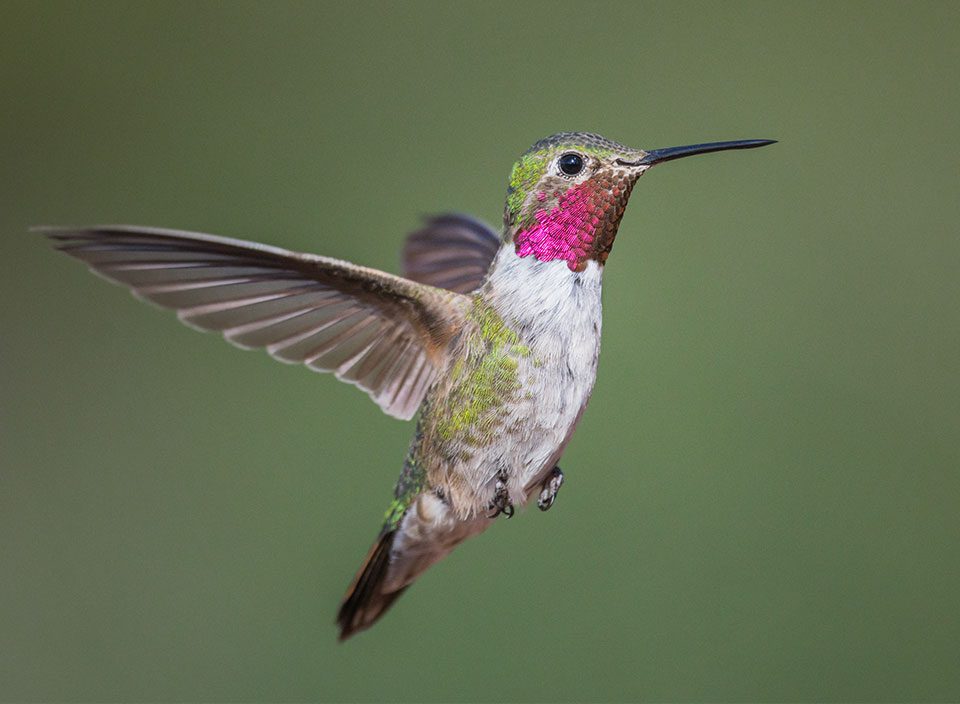
But Stoddard and her team have started to tackle that challenge by training wild Broad-tailed Hummingbirds to participate in color-vision experiments. They set up two hummingbird feeders: one containing sugar water and the other plain water. Beside each feeder they placed LED tubes emitting different colors. For example, the tube beside the sugar water might emit green light, while the one next to the plain water emitted UV combined with green. The researchers periodically swapped the positions of the tube, and controlled the experiments to ensure that the tiny birds were not using smell or other cues to find the reward.
Across 19 different experiments that recorded over 6,000 feeder visits, it took just a few hours for the hummingbirds to consistently visit the rewarding color. And all told, broad-tails were able to distinguish a variety of colors beyond the spectrum visible to humans.
As a part of that research, published in the journal PNAS in 2020, Stoddard and company also tested thousands of plant and plumage colors, and estimated that around 30% of all those colors would be perceived differently by hummingbirds and humans. Because hummingbirds can see parts of the spectrum beyond human limits, “it really multiplies the range of colors that they can perceive in nature,” she says.
Next, Stoddard says she wants to study what Broad-tailed Hummingbirds are seeing when it comes to the wildflowers they are visiting: “It would be very cool to sample the 15 or so wildflower species that hummingbirds visit to see how [the flower] color changes as a function of the nectar reward they are giving out.”
Stoddard says that she thinks this kind of research could be critical to conserving the many-splendored rainbow of hummingbird species in a rapidly warming world. Broad-tailed Hummingbirds have declined by about 45% in the last 50 years, according to the North American Breeding Bird Survey. On the whole, nearly a quarter of all hummingbird species are listed as Near Threatened, Vulnerable, or Endangered by the IUCN.
“Hummingbirds are pollinators, and like all pollinators, they’re especially vulnerable to climate change. When you change one half of the equation [flowering times of the wildflowers hummingbirds rely on], the other half has to change, or suffer the consequences,” she says. “Learning how they see the world helps us anticipate some of the changes we’re likely to see with their migrations and foraging patterns.”
Richard Prum takes it a step further, saying that by studying hummingbird vision, we humans can get a clearer picture of ourselves, too.
Hummingbird color, he says, “makes us think more clearly that we humans are not at the ‘top’ of any hierarchy of nature. [It’s] not about imagining the biological roots of our own complex sensory and psychological experiences … but looking at … branches of the tree of life that are as extraordinary in their ways as we are in ours.
“This perspective is vital to understanding why conservation and preservation of species and habitats is so important to human thriving.”

All About Birds
is a free resource
Available for everyone,
funded by donors like you
American Kestrel by Blair Dudeck / Macaulay Library
